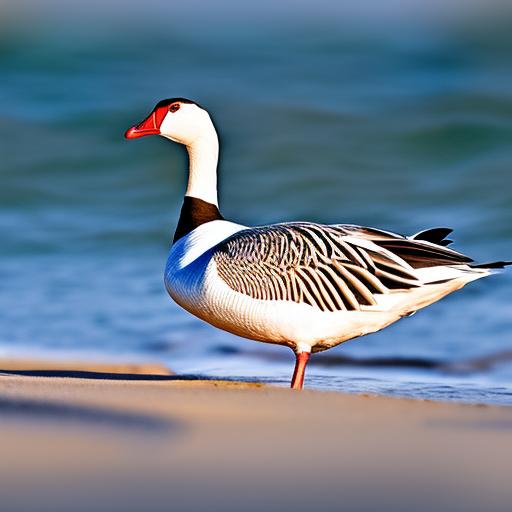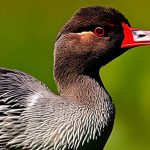Geese are fascinating creatures with complex social structures and behaviors. Understanding their behavior is crucial in finding effective solutions to manage their presence in public spaces. Geese are highly social animals and are known for their strong family bonds. They often travel in large flocks and communicate with each other through honking and body language. Geese are also known for their territorial nature, especially during the breeding season. They can become aggressive when they feel threatened or when their nesting sites are disturbed.
Geese are herbivores and are attracted to areas with abundant grass and water sources. They are also known to be adaptable and can thrive in urban environments, making them a common sight in parks, golf courses, and beaches. Geese are also migratory birds, traveling long distances between their breeding and wintering grounds. Understanding these behaviors can help in developing strategies to manage their presence in public spaces without causing harm to the geese or the environment.
Key Takeaways
- Geese are territorial and protective of their nesting areas, which can lead to aggressive behavior towards humans.
- Establishing physical barriers and using deterrents like noise or motion-activated devices can help keep geese away from unwanted areas.
- Educating beachgoers about the importance of not feeding or approaching geese can help reduce human-goose conflicts.
- Providing alternative habitats such as artificial nesting platforms can encourage geese to nest in more suitable locations.
- Working with local authorities to implement and enforce regulations regarding feeding and approaching geese can help manage the population and behavior of geese in public areas.
- Implementing long-term solutions such as habitat modification and population management can help address the root causes of human-goose conflicts.
- Monitoring the effectiveness of strategies and adjusting them as needed is crucial for successful management of geese behavior in public spaces.
Establishing Boundaries and Deterrents
One effective way to manage the presence of geese in public spaces is to establish boundaries and deterrents to discourage them from congregating in these areas. Physical barriers such as fences or hedges can be used to limit access to certain areas, especially those with sensitive vegetation or nesting sites. These barriers can help create a safe and undisturbed space for the geese while also protecting the surrounding environment.
Deterrents such as noise makers, visual scare devices, and repellents can also be used to discourage geese from settling in public spaces. These deterrents work by creating an environment that is less attractive to geese, thereby reducing their presence without causing harm to the birds. It is important to use humane and non-lethal deterrents to ensure the well-being of the geese and other wildlife in the area. By establishing boundaries and using deterrents, it is possible to manage the presence of geese in public spaces while maintaining a balance between human activities and wildlife conservation.
Educating Beachgoers about Geese
Educating beachgoers about the behavior of geese and the importance of coexisting with wildlife is essential in managing the presence of geese on beaches. Many beachgoers may not be aware of the impact of their actions on the natural habitat of geese and other wildlife. By providing information about the behavior of geese, their nesting habits, and the potential consequences of disturbing them, beachgoers can become more mindful of their actions and their impact on the environment.
Signage and educational materials can be used to inform beachgoers about the presence of geese and the importance of respecting their space. This can help raise awareness about the need to maintain a safe distance from nesting sites and to avoid feeding or approaching the geese. By educating beachgoers about geese, it is possible to foster a culture of respect for wildlife and promote responsible behavior on beaches. This can ultimately lead to a more harmonious coexistence between humans and geese in these shared spaces.
Providing Alternative Habitats for Geese
One long-term solution for managing the presence of geese in public spaces is to provide alternative habitats where they can thrive without causing conflicts with humans. Creating designated areas with suitable vegetation and water sources can help attract geese away from high-traffic areas while providing them with a safe and natural habitat. These alternative habitats can be designed to mimic the natural environment of geese, offering them a space where they can feed, rest, and nest without disturbance.
By providing alternative habitats for geese, it is possible to reduce their presence in public spaces while also promoting their well-being. These habitats can be strategically located in areas where geese are known to frequent, offering them a viable alternative to urban environments. This approach not only benefits the geese but also helps minimize conflicts between humans and wildlife, creating a more sustainable balance between conservation and human activities.
Working with Local Authorities
Collaborating with local authorities is essential in implementing effective strategies for managing the presence of geese in public spaces. Local authorities play a key role in regulating human activities in these areas and can provide support in implementing measures to minimize conflicts with wildlife. By working closely with local authorities, it is possible to develop and enforce regulations that protect the natural habitat of geese while also ensuring the safety and well-being of beachgoers and other visitors.
Local authorities can also provide resources and expertise in managing wildlife populations, including geese, through habitat management, population control, and public education initiatives. By partnering with local authorities, it is possible to create a comprehensive approach to managing the presence of geese in public spaces that takes into account the needs of both wildlife and human communities. This collaborative effort can lead to more sustainable solutions that benefit both geese and the local community.
Implementing Long-Term Solutions

Implementing long-term solutions for managing the presence of geese in public spaces requires a comprehensive approach that addresses the root causes of conflicts between humans and wildlife. This may involve habitat restoration, population management, public education, and community engagement initiatives. By addressing these underlying factors, it is possible to create sustainable solutions that promote coexistence between humans and geese while protecting the natural environment.
Habitat restoration efforts can focus on creating suitable habitats for geese away from high-traffic areas, providing them with alternative spaces where they can thrive without causing disturbances. Population management strategies can involve humane methods such as egg addling or relocation to reduce the impact of geese on public spaces while minimizing harm to the birds. Public education initiatives can raise awareness about the behavior of geese and promote responsible behavior among beachgoers and other visitors.
Monitoring and Adjusting Strategies
Monitoring the effectiveness of strategies for managing the presence of geese in public spaces is crucial in ensuring their long-term success. By regularly assessing the impact of these strategies on both geese and human communities, it is possible to make informed adjustments that improve their effectiveness while minimizing unintended consequences. This may involve tracking changes in goose populations, monitoring nesting success rates, and evaluating the behavior of beachgoers in response to educational initiatives.
Based on this monitoring data, adjustments can be made to existing strategies to better address the needs of both geese and human communities. This may involve refining habitat management efforts, modifying public education materials, or implementing additional deterrents as needed. By continuously monitoring and adjusting strategies, it is possible to create a dynamic approach to managing the presence of geese in public spaces that adapts to changing conditions and ensures a sustainable balance between wildlife conservation and human activities.
In conclusion, managing the presence of geese in public spaces requires a multifaceted approach that takes into account their behavior, habitat needs, and interactions with human communities. By establishing boundaries, providing alternative habitats, educating beachgoers, working with local authorities, implementing long-term solutions, and monitoring and adjusting strategies, it is possible to create sustainable solutions that promote coexistence between humans and geese while protecting the natural environment. Through these efforts, it is possible to manage the presence of geese in public spaces in a way that respects the needs of both wildlife and human communities, creating a more harmonious balance between conservation and human activities.
If you’re looking for ways to keep geese off your beach, you may also be interested in learning about the best flooring options for a chicken coop. Choosing the right flooring can make a big difference in the cleanliness and overall health of your coop. Check out this informative article on PoultryWizard to discover the most suitable flooring materials for your chicken coop.
FAQs
What are some effective methods to keep geese off your beach?
Some effective methods to keep geese off your beach include using visual deterrents such as scarecrows or reflective tape, using auditory deterrents such as noise-making devices, and using physical barriers such as fencing or netting.
Why is it important to keep geese off your beach?
It is important to keep geese off your beach because their droppings can create unsanitary conditions, their presence can be disruptive to beachgoers, and they can damage the natural habitat of the beach.
Are there any environmentally friendly methods to keep geese off your beach?
Yes, there are environmentally friendly methods to keep geese off your beach, such as planting vegetation that is unappealing to geese, using natural predators like dogs or trained falcons, and implementing habitat modification techniques.
What are some potential risks associated with geese on the beach?
Some potential risks associated with geese on the beach include the spread of diseases through their droppings, damage to the beach ecosystem, and conflicts with beachgoers due to aggressive behavior from geese.
Are there any regulations or laws regarding the removal of geese from beaches?
It is important to check with local authorities and wildlife agencies to determine if there are any regulations or laws regarding the removal of geese from beaches. In some cases, permits may be required for certain methods of geese removal.
Meet Walter, the feathered-friend fanatic of Florida! Nestled in the sunshine state, Walter struts through life with his feathered companions, clucking his way to happiness. With a coop that’s fancier than a five-star hotel, he’s the Don Juan of the chicken world. When he’s not teaching his hens to do the cha-cha, you’ll find him in a heated debate with his prized rooster, Sir Clucks-a-Lot. Walter’s poultry passion is no yolk; he’s the sunny-side-up guy you never knew you needed in your flock of friends!







